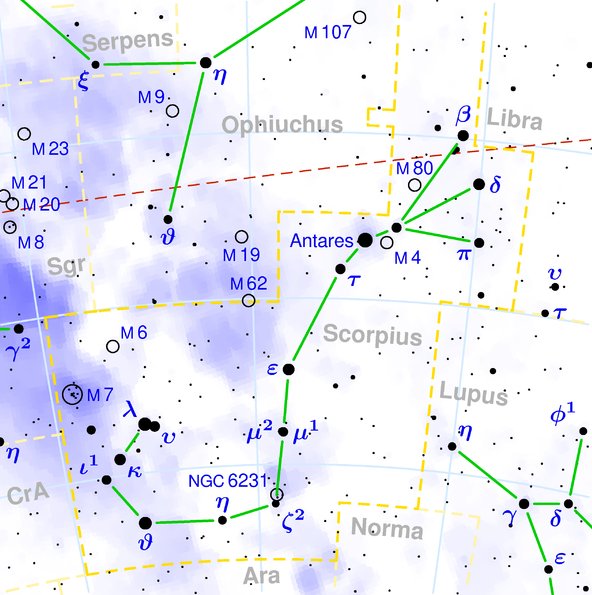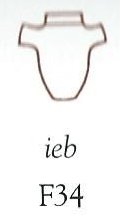The Chinese system has its Heart station
associated with a fox:
|
1 |
Horn |
α
Virginis (Spica) |
Crocodile |
(202.7) |
Oct
9 (282) |
282
= 265
+ 17 |
|
2 |
Neck |
κ
Virginis |
Dragon |
(214.8) |
Oct
21 (294) |
294
= 282
+ 12 |
|
3 |
Root |
α
Librae (Zuben Elgenubi) |
Badger |
(224.2) |
Oct
31 (304) |
304
= 295
+ 9 |
|
4 |
Room |
π
Scorpii (Vrischika) |
Hare |
(241.3) |
Nov
17 (321) |
321
= 304
+ 17 |
|
5 |
Heart |
σ
Scorpii |
Fox |
(247.0) |
Nov
23 (327) |
327
= 321
+ 6 |
|
6 |
Tail |
μ
Scorpii (Denebakrab) |
Tiger |
(254.7) |
Nove
30 (334) |
334
= 327
+ 9 |
|
7 |
Winnowing Basket |
γ
Sagittarii (Nash) |
Leopard |
(273.7) |
Dec
19 (353) |
353
= 334
+ 19 |
For the ancient astronomers this would have been
an obvious clue - the Fox should have been a secure way to allude to
a string
with a 'heart' (a bob of lead), i.e.
a merkhet:
... Evidently,
'heart' is something very specific, as it were the 'center of
gravity' ... See Aeg.Wb. 2, pp. 55f. for sign of the heart (ib)
as expressing generally 'the middle, the center'.
And this may
lead in quite another direction. The Arabs preserved a name for
Canopus - besides calling the star Kalb at-tai-man
('heart of the south') ... Suhail el-wezn, 'Canopus
Ponderosus', the heavy-weighing Canopus, a name promptly
declared meaningless by the experts, but which could well have
belonged to an archaic system in which Canopus was the weight at
the end of the plumb line, as befitted its important position as
a heavy star at the South Pole of the 'waters below'
...
From Spica at the 1st Chinese station (Horn)
- close to the equator - and up to the Great Bear (Ursa
Major) far in the
north there was a 'thong' which the Fox star was nibbling at:
... Proclus informs
us that the fox star nibbles continuously at the thong of the
yoke which holds together heaven and earth; German folklore adds
that when the fox succeeds, the world will come to its end. This
fox star is no other than Alcor, the small star g near
zeta Ursae Majoris (in India Arundati, the common wife of
the Seven Rishis, alpha-eta Ursae ...
In other words, Spica was like a heavy star down at the
end of a merkhet.
There were probably other such such
places for plumb lines, for instance at σ
Scorpii, the star where the 3 lines from
β (Acrab), δ (Dschubba), and π (Vrischika) were joining at the
face of the Scorpion:

 |
 |
 |
 |
|
Gb8-22 |
Gb8-23 (464) |
Gb8-24 (236) |
Gb8-25 (466) |
|
MARCH 12 |
13
(72) |
π |
15 |
|
Al Thurayya-27 /
Krittikā-3 /
Hairy Head-18 |
Menkhib (57.6)
Porrima
|
Zaurak (58.9) |
|
Atiks, Rana (55.1),
CELAENO,
ELECTRA,
TAYGETA
(55.3),
MAIA,
ASTEROPE,
MEROPE
(55.6) |
ALCYONE
(56.1),
PLEIONE,
ATLAS
(56.3) |
|
TAU-ONO |
|
May
15 |
16
(136) |
17 |
18 |
|
SEPTEMBER 11 |
12 |
13
(256) |
14 |
|
π Cor. Borealis, Cor
Serpentis (238.1), Chow (238.6) |
κ Serpentis (239.3),
δ Cor. Borealis, Tiānrǔ (239.5), χ Lupi,
(239.6), ω Serpentis (239.7), Ba, χ Herculis
(239.8). κ Cor. Borealis, ρ Serpentis (239.9) |
β Tr. Austr.
(240.3), κ Tr. Austr. (240.4), ρ Scorpii (240.8) |
Iklīl al Jabhah-15 /
Anuradha-17 /
Room-4 |
|
ξ Lupi, λ Cor.
Borealis (241.1), Zheng (241.2),
VRISCHIKA (241.3),
ε Cor. Borealis (241.5), Dschubba (241.7), η
Lupi (241.9) |
|
November
14 |
15 |
16
(320) |
17 |
 |
 |
 |
 |
 |
|
Gb8-26 |
Gb8-27 |
Gb8-28 (240) |
Gb8-29 |
Gb8-30 (471) |
|
MARCH 16 |
17 |
18 |
19 |
20
(79) |
|
λ
Tauri (59.3), ν Tauri (59.9) |
4h
(60.9) |
no
star listed (61) |
Beid
(62.2)
Vindemiatrix |
Al
Dabarān-2 |
|
no
star listed (60) |
HYADUM I
(63.4) |
|
May
19 |
20
(140) |
21 |
22 |
23 |
|
SEPTEMBER 15 |
16 |
17
(260) |
18 |
19 |
|
υ Herculis (242.3),
ρ Cor. Borealis (242.4), ι Cor. Borealis
(242.5), ξ Scorpii (242.7)
Schedir |
16h
(243.5) |
ψ Scorpii (244.6),
Lesath (244.8) |
χ Scorpii (245.1),
Yed Prior, δ Tr. Austr. (245.5) |
Yed Posterior,
Rukbalgethi Shemali (246.6). δ Apodis (246.7), ο
Scorpii (246.8) |
|
Acrab, Jabhat al
Akrab (243.3), θ Lupi, Rutilicus (243.5), Marfik
(243.7), φ Herculis (243.8)
|
|
November 18 |
19 |
20
(324) |
21 |
22 |
|
no glyph |
 |
 |
 |
 |
 |
|
Ga1-1 |
Ga1-2 |
Ga1-3 |
Ga1-4 |
Ga1-5 |
|
0h (80) |
MARCH 22 |
23 |
24 |
EQUINOX |
26 (*5) |
|
Hyadum II (δ¹ Tauri)
(64.2) |
Net-19 |
no star listed (66) |
no star listed (67) |
Rohini-4
/
ANA-MURI |
no star listed (69) |
|
AIN,
θ¹ Tauri, θ² Tauri
(65.7) |
ALDEBARAN
(68.2), Theemin (68.5) |
|
May 24 (144 = 80 - 64) |
25 (*65 + 80 =
145) |
26 (146) |
27 |
28 (*68 = *64 + 4) |
29 |
|
SEPTEMBER 20 |
21 (*184) |
EQUINOX |
23 (266) |
24 |
25 |
|
Heart-5 |
ρ Ophiuchi
(248.1), Kajam (248.3), χ Ophiuchi (248.5),
She Low, ι Tr. Austr. (248.7), ζ Tr. Austr.
(248.8) |
Al Kalb-16
/
Jyeshtha-18 /
ANA-MUA |
γ Apodis
(250.1), σ Herculis (250.3), θ Tr. Austr.
(250.6), τ Scorpii
(250.7) |
Han (251.0) |
ζ Herculis, η
Tr. Austr. (252.1), η Herculis, β Apodis
(252.5) |
|
σ SCORPII
(247.0), Hejian (247.2), ψ Ophiuchi (247.7) |
ANTARES
(249.1), Marfik, φ Ophiuchi (249.5),
ω
Ophiuchi (249.8) |
|
November 23 |
24 (145 + 183 = 328) |
25 (*249 + 80 =
329) |
26 (330 = 266 + 64) |
27 |
28 |
Possibly we should perceive a string of measurement
hanging down at left in Ga1-2, alluding to a
connection in time between heliacal Taurus and
nakshatra Scorpius at the opposite side of the year.
I have taken as a rule of thumb to add
183 (= 366 / 2) days (and glyphs) to the positions of the heliacal stars
in order to find the positions of the corresponding
nakshatra stars. But counting with 365¼
/ 2 = 182.625 - approximated as 182 days - would put Antares
precisely at
the opposite side of the sky compared to Ain.
A string
across from Antares to Ain could be imagined, across
from SEPTEMBER 22 to MARCH 22.
|






